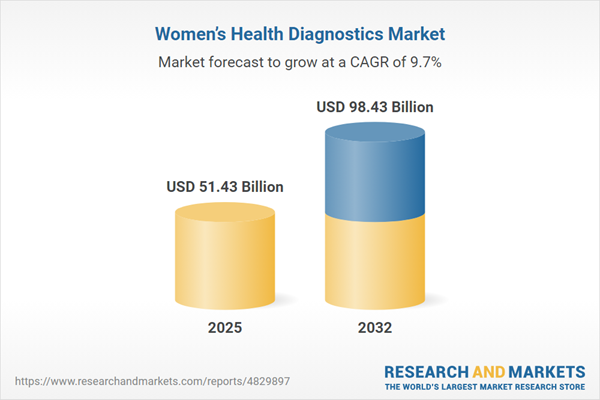Speak directly to the analyst to clarify any post sales queries you may have.
The Women's Health Diagnostics Market is experiencing transformative growth, driven by technology integration, evolving patient needs, and strategic collaborations across the diagnostic landscape. Senior decision-makers benefit from in-depth insights that clarify opportunities, challenges, and actionable strategies in this critical healthcare segment.
Market Snapshot: Women's Health Diagnostics Market
The Women's Health Diagnostics Market grew from USD 46.82 billion in 2024 to USD 51.43 billion in 2025. Projected to expand at a CAGR of 9.73%, the sector is expected to reach USD 98.43 billion by 2032. This rapid progress is shaped by new clinical approaches, rising demand for early detection, and adoption of point-of-care technologies, positioning the market for significant evolution over the forecast period.
Scope & Segmentation
This report delivers structured analysis of the Women’s Health Diagnostics Market, providing clarity across major segments and covering regional and technology trends.
- Disease Indications: Cardiovascular conditions, infectious diseases (HIV, human papillomavirus), metabolic disorders (diabetes, thyroid disorders), oncology (breast, cervical, ovarian cancers), and pregnancy and fertility (ovulation and pregnancy tests).
- Test Types: Benchtop instruments, point-of-care instruments, immunoassays, lateral flow assays, molecular diagnostic kits, informational software, and services.
- Technologies: Biochemical analysis methods such as colorimetry and fluorometry, immunoassays, molecular diagnostics including next-generation sequencing and PCR.
- End Users: Home care settings, hospitals and diagnostic centers, and research laboratories.
- Sample Types: Blood, saliva, tissue, urine.
- Distribution Channels: Direct sales, distributors, online channels.
- Regions: Americas (United States, Canada, Mexico, Brazil, Argentina, Chile, Colombia, Peru), Europe (United Kingdom, Germany, France, Russia, Italy, Spain, Netherlands, Sweden, Poland, Switzerland), Middle East (United Arab Emirates, Saudi Arabia, Qatar, Turkey, Israel), Africa (South Africa, Nigeria, Egypt, Kenya), Asia-Pacific (China, India, Japan, Australia, South Korea, Indonesia, Thailand, Malaysia, Singapore, Taiwan).
- Leading Companies: Abbott Laboratories, Becton Dickinson, Biomérieux SA, Cardinal Health, Carestream Health, Chembio Diagnostic Systems, Danaher Corporation, FUJIFILM Holdings, GE Healthcare, Hologic, Quest Diagnostics, Siemens AG, Thermo Fisher Scientific, and others.
Key Takeaways for Senior Decision-Makers
- No single solution dominates — instead, growth is propelled by simultaneous advancements in molecular sequencing, immunoassays, and integrated software solutions.
- Point-of-care testing adoption accelerates the shift toward decentralized diagnostics, improving accessibility and meeting the unique needs of underserved populations.
- Strategic alliances between diagnostics manufacturers, biotech innovators, and academic consortia foster rapid commercialization of next-generation assays, supporting more personalized and precise care delivery.
- Digital transformation, especially integration of AI and secure mobile applications, increases engagement, facilitates real-time monitoring, and enhances value for healthcare providers and payors.
- Regional growth trajectories differ—established markets prioritize regulatory alignment and infrastructure modernization, while emerging markets emphasize cost-effective solutions and local manufacturing strength.
- Commercial success depends on cross-functional collaboration, agile supply chain strategy, and a deep understanding of changing reimbursement and regulatory landscapes.
Tariff Impact Across Supply Chains and Innovation
U.S. tariffs implemented in 2025 created notable shifts in procurement strategies and cost structures. Manufacturers reliant on international supply chains have faced cost pressures for key components and reagents, prompting greater investment in local sourcing and alternative suppliers. These dynamics unlocked opportunities for regional producers and increased focus on risk mitigation, without major disruption to test pipeline continuity. Recalibrated pricing models and stakeholder engagement across procurement and innovation remain essential for effective tariff navigation.
Methodology & Data Sources
This report employs a multi-method approach, blending primary interviews with industry and clinical experts with robust secondary research drawn from peer-reviewed publications, regulatory documents, and industry consortium data. Quantitative analysis leverages cross-validated datasets and advanced modeling to ensure reliable trend and segmentation insights.
Why This Report Matters
- Enables data-driven decisions by providing actionable intelligence on technology trends, regional developments, and strategic partnerships in women’s health diagnostics.
- Helps anticipate regulatory, reimbursement, and supply chain challenges to secure operational resilience and market competitiveness.
- Identifies evolving patient needs and innovation pathways, supporting the design of adaptive diagnostic portfolios and successful business development strategies.
Conclusion
Women's health diagnostics is rapidly evolving through innovation, collaboration, and targeted market strategies. Leaders equipped with granular market insights can position their organizations for continued growth and sustainable competitive advantage.
Additional Product Information:
- Purchase of this report includes 1 year online access with quarterly updates.
- This report can be updated on request. Please contact our Customer Experience team using the Ask a Question widget on our website.
Table of Contents
3. Executive Summary
4. Market Overview
7. Cumulative Impact of Artificial Intelligence 2025
Companies Mentioned
The companies profiled in this Women’s Health Diagnostics market report include:- Abbott Laboratories
- AccuBioTech Co., Ltd.
- Becton, Dickinson and Company
- Biomérieux SA
- Cardinal Health, Inc.
- Carestream Health, Inc.
- Chembio Diagnostic Systems, Inc.
- Cook Medical, Inc.
- Danaher Corporation
- DIALAB GmbH
- EKF Diagnostics Holdings PLC
- F. Hoffmann-La Roche Ltd.
- FUJIFILM Holdings Corporation
- GE Healthcare
- Guided Therapeutics, Inc.
- Hologic, Inc.
- Koninklijke Philips N.V.
- MedGyn Products, Inc.
- NeuroLogica Corporation
- Nova Biomedical
- Perkinelmer Inc.
- Quest Diagnostics Incorporated
- Siemens AG
- SuperSonic Imagine
- Werfen, S.A.
- OSI Systems, Inc.
- Hill-Rom Holdings, Inc.
- Bio-Rad Laboratories, Inc.
- Sekisui Diagnostics, LLC
- Thermo Fisher Scientific Inc.
Table Information
| Report Attribute | Details |
|---|---|
| No. of Pages | 187 |
| Published | November 2025 |
| Forecast Period | 2025 - 2032 |
| Estimated Market Value ( USD | $ 51.43 Billion |
| Forecasted Market Value ( USD | $ 98.43 Billion |
| Compound Annual Growth Rate | 9.7% |
| Regions Covered | Global |
| No. of Companies Mentioned | 31 |









